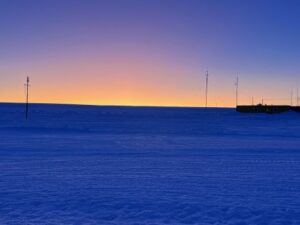© Erin Solaro, 2024
What can be said about Antarctica beyond the obvious?
Which is that it is the fifth largest continent, 1.5 times the size of the continental United States, a desert covered with a layer of ice that averages a mile thick and is up to 3 miles thick. This is 70% of the earth’s freshwater, and it is enough to raise the global sea levels by 200 feet / 61 meters and drastically change ocean temperature if the sheet melts completely.
Antarctica is governed, if you want to call it that, by the Antarctic Treaty, which stipulates Antarctica can be used only for peaceful purposes, to ensure scientists can freely research and co-operate, so their observations and results can be exchanged and made available to the larger world. Formally, Antarctica is a demilitarized continent, but don’t kid yourself. The cold and the wind are immediate dangers, the maintenance is constant, and you’re a fool, for example, if you’re an American at Novolazarevskaya airbase, a Russian asset, if you try to start a conversation about Ukraine or Vladimir Putin. Cooperation is absolutely essential to survival, even if the military planners of every nation with Antarctic bases (and some that don’t) are likely thinking seriously about Antarctica and what to do when or if the current international order shifts or breaks down.
Because governments are in Antarctica for one reason alone. Resources. Especially whatever may lie under all that ice. Science, to which everyone pays lip service, and to which many are deeply devoted, comes a distant second in national budgets and planning.
I went to Antarctica for the 2023 scientific season at the behest of Jennifer Pritzker (full disclosure: we are married), who has personally participated in four expeditions and sponsored or co-sponsored several more through the Tawani Foundation. I had suggested she go on another, and if she wanted to, I would go with her in suffering solidarity. I was under no illusions that this was anything but living in tents, going without showers, and eating mostly freeze-dried food for six weeks. Instead, Jennifer suggested I go with the team, without her.
Stone cold sober, not even on a caffeine jag, I said… Sure. Surprised because I had never wanted, let alone intended, to go to Antarctica (or the Arctic)... but not really, because other people think about moving south as they age. I think about moving north.
Team lead was Dale Andersen, Senior Researcher of the SETI (Search for Extraterrestrial Intelligence) Institute and one of the world’s most accomplished ice divers. Camp Manager was Miles Ecclestone, a wiry Canadian, retired from Trent University. Junior diver was Lara Vimercati, an Italian now with the Museum of Natural History in London. Birgit Sattler and Klemens Weisleitner represented the University of Innsbruck and Andre Pellerin and Daniel Fillon, the University of Quebec at Rimouski. Eccleston and I were the odd ones out, lacking Ph. D.s, although he really should have one, but as he told me, without a Ph. D., he was able to do all the fun stuff without having to do any of the admin work that often comes with a Ph. D. I was the artist in residence, providing useful casual labor, be it fetching water or helping build a meteorological station when I was, you know, actually in Antarctica.

Because a lot of the time, I wasn’t.
On 14 October, Birgit and Klemens and I flew out of Munich to Capetown to assemble with the rest of the team. There we stayed until 27 October, waiting for the Antarctic weather to clear and Novolazarevskaya’s blue ice runway to be groomed. Our logistics were provided by Ultima Antarctic Logistics, including the aircraft we flew in and out on, an Il-76TD-90VD, NATO name Candid. Candid is a 4-engine turbofan strategic airlifter and this particular variant was developed for, owned, maintained, and crewed by Volga-Dnepr Airlines. Candid was obviously designed and built to fly into harm’s way, then bring its crew back out alive if at all possible, and it's the aircraft you wanna see on the strip if you’re flying into Antarctica.
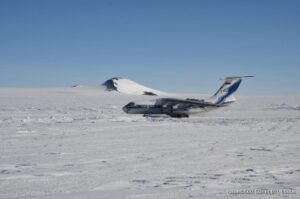
In Capetown, on 19 October, I developed some kind of GI unpleasantness, including constant low-grade nausea that would last until 15 November. While I had reason to believe I was improving, the unpleasantness became so severe that, having helped load equipment for the traverse out to our deep field site at Lake Untersee, I had to be medevac’d back to Capetown on 3 November. What is merely miserable in Capetown can go sideways very fast and very badly in Antarctica at a base, let alone in the field.
I was in Capetown until 29 November, recovering (all tests being negative), then waiting for weather clearance. Every day in Capetown, I argued with myself about returning to Antarctica. Frankly, I had been quite ready to return home to Jennifer and our cat Samantha the day I flew out of Munich! I was uneasy about my gut, I love hot showers and fragrant soap, I detest flying, and I was afraid of the cold and the wind.
During those solitary days, I had time to think about some of the not-so-obvious truths of Antarctica.
Every single person who goes to Antarctica is driven by ego. This is not limited to the explorers and extreme athletes. In my case, I had agreed to do something, and my pride and self-respect were on the line. And let’s face it. Deep field expeditions to Antarctica give bragging rights.
Ego drives everyone who comes to Antarctica, from explorers, whether vainglorious or curious, to the most dedicated scientist, whether raging egomaniacs or the deeply humble. Ego drives the guides and the cooks and the mechanics. Ego can be the self-indulgent embrace of the common, disturbing, and utterly boring trope of Antarctica as white, virginal continent awaiting exploration and conquest because “man” is tougher than nature. That is hubris. But ego can also be driven by the hope of seeing the magic and mystery of Antarctica, the ability to see it when it actually reveals itself to you, and your desire to share something of that magic and mystery with so many who can never, and may never want, to go.
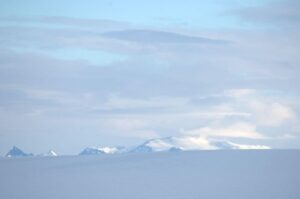
© Erin Solaro, 2023
Antarctica is still the only continent humans have never permanently settled because it is so remote and so harsh that even bacteria have a hard time making a living there. And it is stunningly, terrifyingly beautiful. On the traverse back from Lake Untersee, nothing but ice and hard pack snow for kilometers, I wanted to call a halt to photograph a massive white dome of a lenticular cloud, its “rings” tinted peony and rose and lilac, in a clear blue sky. But we were racing weather, I had had a frightening incident with my hands at an earlier halt, and while I quickly re-established self-control, I wasn’t eager to repeat the experience. So I can only share that astonishing sight in words inadequate to the intense beauty.
All these things, I was prepared for.
Nothing could have prepared me for the shock, from which I have not really recovered, of realizing Antarctica, for all its surface difference, is exactly like the rest of the planet. Including your own backyard or favorite park. The only difference is: You can’t lie to yourself in Antarctica.
The world, none of it, this amazing, astonishing, intricate network of perhaps 10 million species of fungi, plants, animals, insects, fish, molluscs, crustaceans, and on and on and on, cares not at all about our lives or deaths. But we are entirely bound to that web, and the more we damage it, the more we endanger ourselves.
Antarctica is so absolutely in your face about that truth that the most dangerous days are when it’s clear and sunny, blue skies and white clouds, temperature is about 0-2 degrees Celsius, and there’s no wind. The overwhelming, outrageous beauty of those fine hours can lull you into thinking, This place isn’t so tough after all. As my brain processed that reflexive bit of idiocy, the hair on the back of my neck stood up and the backs of my hands prickled hot with the fear of real danger.

© Erin Solaro, 2023
Yes, it is, yes, Antarctica is. Here, panic can kill you quickly, but fear can keep you alive.
And yet this extraordinary harshness is what draws scientists, and for reasons far beyond the possibility of exploring one’s capabilities. Antarctica strips away a great deal of the “noise” of our modern world, whether that is advertising or chemical signals. As a continent, it is so cold and dry and remote from the wider world that it is as close as we can come, to explore what life might look like on our moon, or Mars, or farther out in the galaxy. While to dive beneath the ice cover of Lake Untersee is as close as you can come to the beginnings of life on our world—and perhaps others. Indeed, you can probably gather more data about the beginnings of life at the bottom of Lake Untersee than anywhere else on earth, and that is what led Tawani to fund expeditions to Lake Untersee in Antarctica, in 2008, 2014, and now 2023.


© Erin Solaro, 2023
Lake Untersee is on the inland side of the Gruber Mountains in Queen Maud Land, about 90 km from Novolazarevskaya airfield. Distance, however, is usually less meaningful than time in Antarctica. So, about 18 hours by Evererst, a massive tracked snow groomer we used to haul our sea crate full of equipment the day the team left, the day before I flew back to Capetown. About 20-30 minutes by the Twin Otter in which I flew out to Lake Untersee when I returned to Antarctica. About 7 hours riding pillion on a skidoo, using everything I learned on a horse to be a good passenger for Daniel Fillion, while the Everests made similarly good time on the return. Another way to put this is, if anything goes wrong, you are a long way from help.
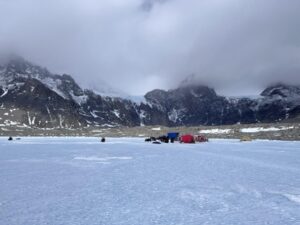
© Erin Solaro, 2023
This may sound like an arcane waste of money and sweat, because our deep field site required significant physical labor: since there was no suitable land to pitch most of our tents, the rest of team built platforms on the ice, screwing plywood sheets to 2 x 4s and 2 x 6s. The process requires hand-carrying the plywood and 2-bys from where they had been stored on land to overwinter, over very rocky ground, loading them onto a sledge pulled by skidoo. Rocks were also loaded onto the skidoos. Once the platforms were built, the tents were pitched on top, then “rocked” into place from inside, while more rocks were placed outside as anchor points for guy lines. That, of course, was the beginning of the labor, which concluded with reversing the process when we tore down the camp and traversed back to Novolazarevskaya.
Consider, though. Lake Untersee was discovered by the German Antarctic expedition of 1938-39, when the Reich government was studying the feasibility of establishing a station to harvest whale oil for margarine. Rather than, you know, making butter at home, and a few less guns. Now that’s an arcane, and utterly irrational, waste of money!
The Tawani expedition of 2008 found living, instantly motile bacteria in freshly thawed samples of ancient ice from the Anuchin Glacier that feeds into Lake Untersee from the north, and the ice cover of the lake itself. That discovery, combined with the discovery of living bacteria in ice cores from Vostok in Antarctica and the Fox Tunnel, raises the possibility of cyro-preserved, even living, bacteria on Jupiter’s moons and Mars. It also suggests that microbial life can be transferred between planetary masses by impacts in polar ice sheets.
More interesting is the water chemistry of Lake Untersee. For perhaps 100,000 years, it has been covered by a layer of ice that averages 3 meters thick in the austral summer. The Anuchin Glacier to the north slides slowly into the lake, where it melts, while the ice cover either sublimates into the atmosphere, transitioning from ice to water vapor without ever becoming water, or is ablated away, most likely ending up in the mountains. The glacier is a possible source of bacteria, especially from snow petrels. Another source is cryoconite, a mixture of rock particles, including from meteorites, which originate off-planet, soot, microbial matter, including from snow petrels and skuas, and now microplastics. Darker than the ice, cryoconite absorbs solar energy, gradually melting into the ice and forming a cryoconite hole, often containing water and attracting various cold-adapted microorganisms such as tardigrades, AKA water bears and moss piglets.
These microorganisms end up at the bottom of Lake Untersee, where the water is tens of thousands of years old and so clean we drank it without treatment. (One of the duties I assigned myself was refilling our water barrels.) Nevertheless, over the millenia, those microorganisms have created large conical stromatolites and smaller microbial pinnacles at the bottom of Lake Untersee. We know this because teams, including Laura Vimercati on her first under-ice dive, led by Dale Anderson, have melted dive holes through those 3 to 4 meters of ice, taken photos, and retrieved samples.
Why go through such trouble and expense, in an unremittingly dangerous environment? One reason is that at that particular place, Lake Untersee offers an anoxic well. At about 70 meters deep, scientists can observe an almost hermetically-sealed carbon cycle. The microorganisms in the lake are able to extract carbon from dissolved CO2 to replicate themselves, just as plants are able to, by extracting carbon from atmospheric CO2, rather than from decaying organic matter.
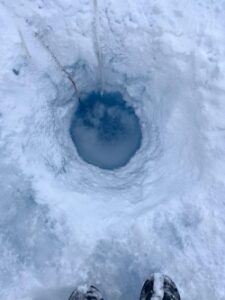
© Erin Solaro, 2023
The Canadians, Andre Pellerin and Daniel Fillon, were interested in some cryptic data from samples from previous expeditions beneath Lake Untersee because careful parsing revealed significant anomalies in how nitrogen, carbon, and sulfur interact. The intriguing question they hope to answer is, Is this interaction actually an anomaly? Or is this interaction masked by other, more powerful interactions that are not possible in Antarctica because of the pristine environment? If so, if that interaction is not an anomaly, then this specific chemical reaction may be able to be replicated in other anoxic environments, outside of Lake Untersee. If that is possible, and can then be replicated on an industrial scale, the chemical interaction found at Lake Untersee will have important implications for both sewage treatment and, even more so, agricultural pollution. There is a great deal of work to be done by a great many people to reach that end, if it is in fact possible.
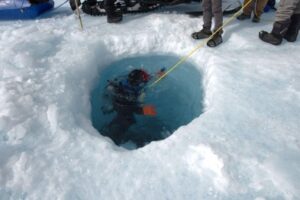
© Erin Solaro, 2023
But that interaction, unknown before it was discovered in Lake Untersee, could not have been found in normal, oxic environments, because other chemical reactions prevented it from occurring at all.
Perhaps this is Antarctica’s bluntest lesson.
Even the most astonishing scientific discoveries, like the Haber-Bosch process, which revolutionized the use of fertilizers to increase agricultural yields and save literally hundreds of millions of people from starving to death, build upon a myriad of tiny steps. Undersea communications cables began with women who needed to bundle things together, and wondered if twisting grass together would do it. That single, as spinsters call them, likely didn’t do it. But plying two singles together in the opposite direction, a Z-twist as opposed to the S-twist of the singles (or vice versa) certainly did a much better job. Soon, you have a usable cord and the beginning of what would become the great quadriga of human civilization: silk and linen, cotton and wool. Including our own clothing, whether it is woven or knit.
I doubt you’d feel great flying on an unregulated airplane, but the truth is, the CDC estimates about 3,000 Americans die of food-borne illnesses while more than 127,000 are hospitalized and nearly 48 million sickened. A year. Conversely, in 2021, there were 176 air traffic fatalities worldwide. And you know how miserable food poisoning is, even if it “just” sickens you. In short, our comfort, our very lives, depend on an amazingly complicated web of knowledge, standards, and regulations across multiple industries, some international, literally tens if not hundreds of thousands of years in the making. This requires tremendous cooperation and collaboration: no rugged individualists need apply. They’re likely to get themselves or others killed and leave you stuck handling their bodies.
Here, in our comfortable lives, we can fool ourselves about such things. For a time. You can’t fool yourself in Antarctica. Where I do expect to return.
